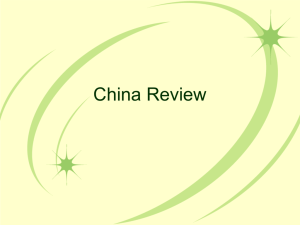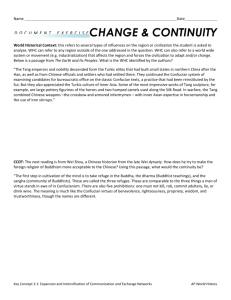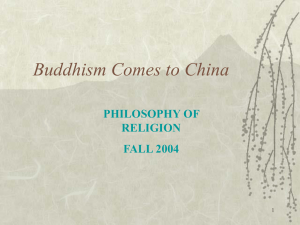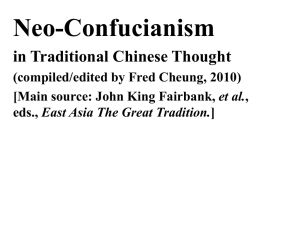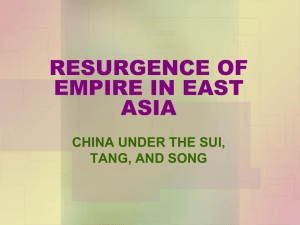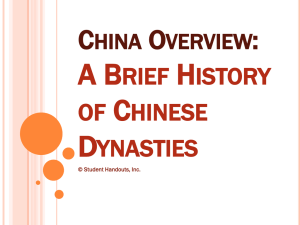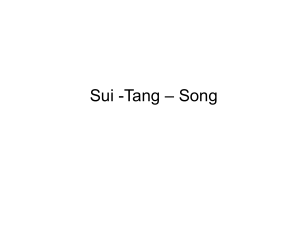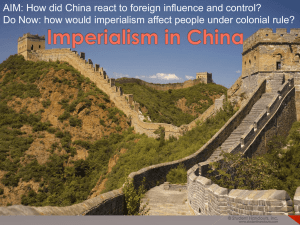CHINESE MODEL
advertisement
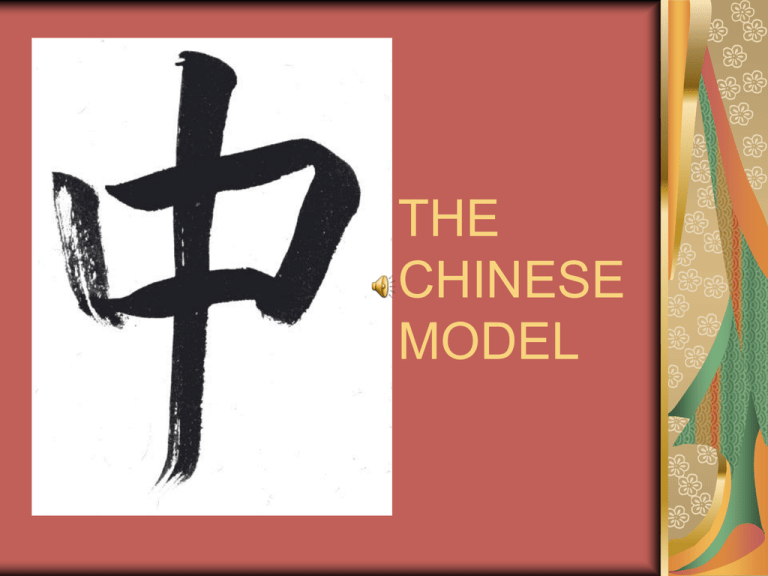
THE CHINESE MODEL Definition of the Chinese Model Political, social, economic, religious, and cultural aspects of Chinese civilization spread to Korea, Japan, and Vietnam during the Tang Dynasty (618 – 907 C.E.) and Song Dynasty (960 – 1279 C.E.) Tang Dynasty 618 -907 C.E. Chinese model political structure -- imperial bureaucracy -- expansion of civil service system based on tests of Confucian knowledge Chinese model social structure emperor and his family scholar-officials; military elite peasants craftspeople merchants prostitutes, actors, other itinerant entertainers Chinese model gender structure patriarchy but elite women educated women’s status fell during Song – foot binding More opportunities for men in the civil service Chinese model technology new printing techniques new hydropower for iron production assembly line manufacturing of porcelain increased production of silk -household labor and organization Buddhist books printed Silk production industrialized Song Daoists invented south-pointing compass; also used on Chinese ships Chinese model demography increased production of foods, especially double crops of rice led to growth in population and then deforestation Chinese model for Interaction --Trade on the Silk Road(s) -- War (Battle of Talas River, 751) Talas River Chinese model cultural and intellectual developments Tang Dynasty supported expansion of Buddhism with imperial patronage Endowed monasteries Hosted Buddhist ceremonies at court Gave tax-exempt status to Buddhist monasteries Encouraged Buddhist monasteries to act as banks for merchants on the Silk Roads Chinese poetry reached its height during the Tang Dynasty Wang Wei, Buddhist poet Bai Juyi, Confucian poet Li Bai, Daoist poet Empress Wu Zetian Tang Dynasty (684-705 CE) made Mahayana Buddhism state religion→powerful monks and monasteries commissioned Buddhas in Luoyang caves identified herself with Buddha of the Future, Maitreya, and a Boddhisatva Han Yu, leading Confucian scholar and official at the Tang imperial court, -“Memorial on Buddhism,” 819 C.E. “Your servant begs leave to say that Buddhism is no more than a cult of barbarian peoples spread to China. It did not exist here in ancient times.” Han Yu’s Memorial to the Emperor, continued “Now I hear that Your Majesty has ordered the community of monks to go to greet the finger bone of the Buddha, and that Your Majesty will ascend a tower to watch the procession as this relic is brought into the palace. If these practices are not stopped, and this relic of the Buddha is allowed to be carried from one temple to another, there will be those in the crowd who will cut off their arms and mutilate their flesh in offering to the Buddha.” Han Yu’s Memorial to the Emperor “Confucius said: ‘Respect ghosts and spirits, but keep them at a distance!’” “Your servant is deeply ashamed and begs that this bone from the Buddha be given to the proper authorities to be cast into fire and water, that this evil be rooted out, and later generations spared this delusion.” Tang Emperor Wu, “Edict on Buddhism,” 845 C.E. “At present there are an inestimable number of monks and nuns in the empire, all of them waiting for the farmers to feed them and the silkworms to clothe them while the Buddhist public temples and private chapels have reached boundless numbers, sufficient to outshine the imperial palace itself.” Tang Emperor Wu, “Edict on Buddhism,” 845 C.E., continued “Having thoroughly examined all earlier reports and consulted public opinion on all sides, there no longer remains the slightest doubt in Our mind that this evil should be eradicated.” Song Dynasty, 960 – 1279 C.E. Patronage of Confucianism Sent Confucian teachers through country Social conservatism and Confucian stress on social hierarchy Limited role of women – Song believed Buddhism encouraged women to meddle in politics. Encouraged foot-binding for elite women Neo-Confucianism used Daoism and Buddhism to explain evil and misfortune imbalance of Qi (spiritual energy) could be corrected with Ren (humaneness). Ren achieved through li (ritual, the Confucian rules for behavior) How did the Chinese model spread in East Asia? through trade and Tang imperial expansion (tribute system) arts, e.g. official portraits technology including writing and printing systems plans of capital cities bureaucracies and examination systems Korean Confucians The temple of Literature is dedicated to Confucius. It was built in 1070. by the Emperor of Vietnam. City plan of Changan, Chinese capital City plan of Nara, Japanese capital Spread of Buddhist art Emaciated Shakyamuni Buddha, Pakistan, 3rd c. C.E. Gandharan style Buddha (syncretism of Indian and Hellenistic art, 2nd century C.E.) Seated Buddha, Dunhuang Caves, China, Northern Wei, 3rd- 6th c. C.E. Buddha, Tang Dynasty, 7th c. C.E. Longmen Caves KOREAN BUDDHA SOKKURAM (751) Seated Shakyamuni Buddha, Sokkuram Grotto, Korea, Unified Silla, c. 751 C.E. Great Buddha, Nara, Japan, Heian period, c. 752 C.E. Amitabha Buddha, Japan, Heian Period, 11th-12th c. C.E. What are examples of resistance to the Chinese model? bureaucracies and examination systems limited to military elite in Korea and Japan no foot binding outside of China – elite Korean, Japanese and Vietnamese women kept higher status Japanese military leader: MINAMOTO YORITOMO (1147-1199 CE). Japanese Hierarchy Emperor (mostly symbolic) Shogun (military ruler) Daimyos (feudal lords) Samurai (feudal warriors) Peasants/Craftspeople/Merchants Outcasts/Eta (workers who deal w/dead bodies, animals, sewage, leather) Korean Hierarchy King Nobility Confucian scholar-bureaucrats Peasants Craftspeople Merchants Korean shamans often were women AMATERASU OMIKAMI Japanese Goddess, founder of the Japanese people SHINTO PRIESTESSES Vietnamese Trung Sisters Defeated the Han Army and Ruled as Queens To what extent did the Chinese model spread to East Asia?


